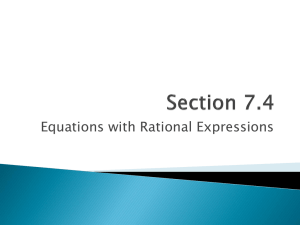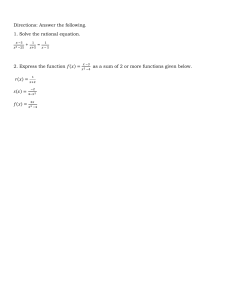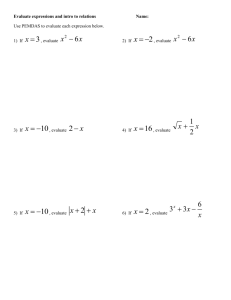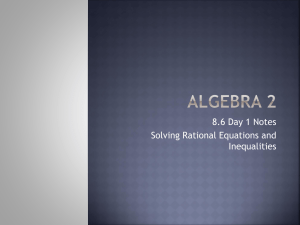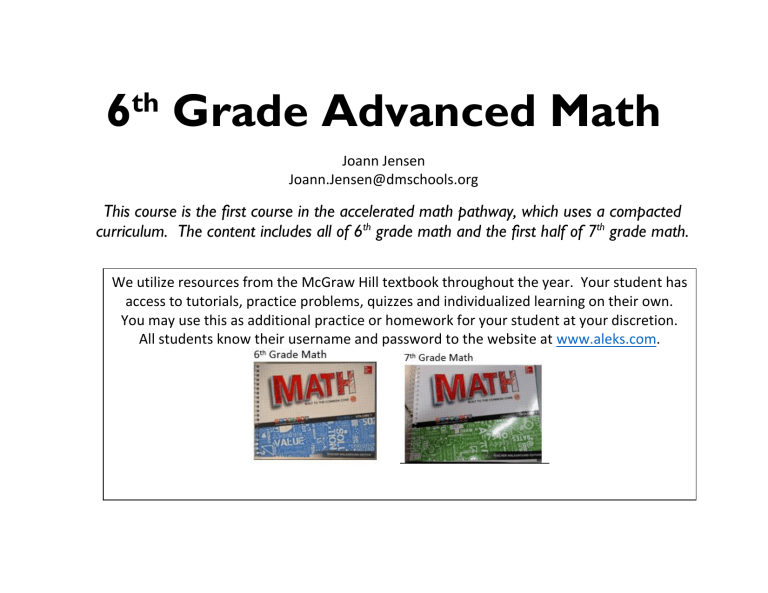
6 Grade Advanced Math th Joann Jensen Joann.Jensen@dmschools.org This course is the first course in the accelerated math pathway, which uses a compacted curriculum. The content includes all of 6th grade math and the first half of 7th grade math. We utilize resources from the McGraw Hill textbook throughout the year. Your student has access to tutorials, practice problems, quizzes and individualized learning on their own. You may use this as additional practice or homework for your student at your discretion. All students know their username and password to the website at www.aleks.com. Semester 1 Unit Estimated Duration Unit One: The Number System 5 weeks Unit Two: Ratios and Proportional Relationships (major) 6 weeks Unit Three: Integers 3 weeks Unit Four: Rational Numbers (major) 2 3 weeks Grading Topics Iowa Common Core Standards 6.NS.B.2, 3 • • Decimal Operations (yearlong) • Ratio and Proportional Reasoning • Percents • Integers • Addition and Subtraction of Rational Numbers Multiplication and Division of Rational Numbers 7.NS.A.1,3 Expressions Equations Functions and Inequalities 6.EE.A.1, 2, 3, 4 6.EE.B.6, 7 6.EE.B.5, 8 • Multiplying and Dividing Fractions 6.NS.A.1 6.RP.A.1,2,3; 7.RP.A.2 6.RP.A.3; 7.RP.A.3 6.NS.C.5, 6, 7, 8, 6.G.A.3 7.NS.A.2 Unit Five: Expressions and Equations (major) 8 weeks • • • Unit Six: Geometry 4 weeks • Surface Area and Volume 6.G.A.1, 2, 4 Unit Seven: Statistics and Probability 5 weeks • Statistical Measures and Displays 6.SP.B.5, 6.SP.A.2, 6.SP.B.4 Unit One: The Number System Organizing Principles Students continue their previous understanding of the meaning of fractions, the meanings of multiplication and division, and the relationship between multiplication and division to explain why the procedures for dividing fractions make sense. Students use visual models and equations to divide whole numbers by fractions and fractions by fractions to solve word problems. Unit Two: Ratio and Proportional Relationships Organizing Principles Students are introduced to ratio, a relationship or comparison of two quantities or measures. Students represent ratios in various forms and compare types of ratios. At this level, they use reasoning about multiplication and division to solve ratio and rate problems about quantities. Students learn how and where ratios and rates are used in the real world. These standards extend what students learned in Grade 6 about ratios to analyzing proportions and proportional relationships. Students calculate unit rates with complex fractions and move to recognizing and representing proportional relationships in equations and on graphs. These skills and understandings are used to solve multi-step ratio and percent problems involving real-world scenarios such as interest, tax, shopping sales, and so on. Unit Three: Integers Organizing Principles At this level, students use fractions, decimals, and integers to represent real-world situations. They extend the number line to represent all rational numbers and recognize that number lines may be either horizontal or vertical which helps sixth graders move from number lines to coordinate grids. The focus of this unit is to learn about negative numbers, their relationship to positive numbers, and the meaning and uses of absolute value. This unit lays the foundation for working with rational numbers, algebraic expressions and equations, functions, and the coordinate plane in seventh and eighth grades. Unit Four: Rational Numbers Organizing Principles Students develop an understanding of number, recognizing fractions, decimals, and percents as different representations of rational numbers. Students extend addition, subtraction, multiplication, and division to all rational numbers and explain and interpret the rules for adding, subtracting, multiplying, and dividing with negative numbers. Students solve real-world and mathematical problems involving all four operations with rational numbers. Unit Five: Expressions and Equations Organizing Principles The study of expressions and equations centers on the use of variables in mathematical expressions. Students write and evaluate numerical expressions and use expressions and formulas to solve problems. Students also solve simple one-step equations and use equations such as 3x = y to describe relationships between quantities. The sixth-grade study of expressions and equations is foundational in the transition to algebraic representation and problem solving, which is extended and formalized in Grade 7. Unit Six: Geometry Organizing Principles Students in Grade 6 build on their understanding of area and volume from Grade 5 to deepen understanding of volume and develop the concept of surface area. Students prepare for their work in Grade 8 with transformations by working with polygons in the coordinate plane in Grade 6. Reasoning about relationships in their work on surface area, composing and decomposing shapes, and finding distance on a coordinate plane using endpoint coordinates for horizontal and vertical lines prepare them for Grade 7 relationships. Unit Seven: Statistics and Probability Organizing Principles A major focus for sixth graders is to develop an understanding of statistical thinking. Students study measures of center and variability with newly learned knowledge of mean, median, mode, and range. Using dot plots, histograms, and box plots, students draw inferences and make comparisons between data sets. At this level, students recognize that a data distribution may not have a definite center and that different ways to measure center provide different values. Students discover that interpreting different measures of center for the same data develops the understanding of how each measure can change how data get interpreted.
